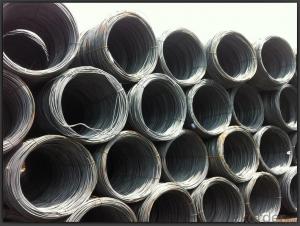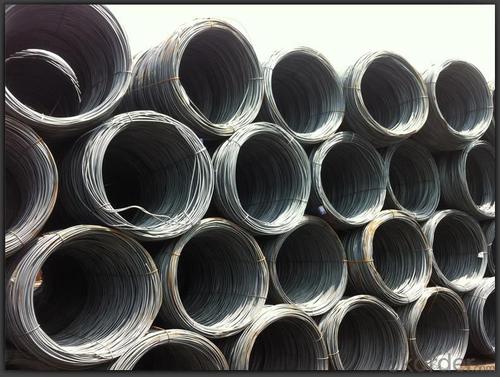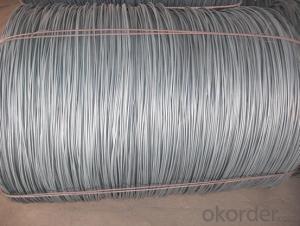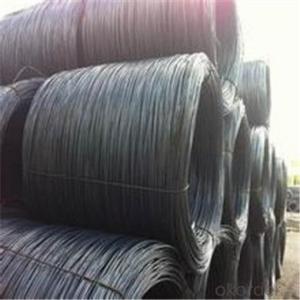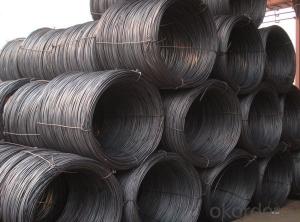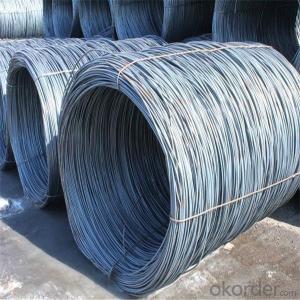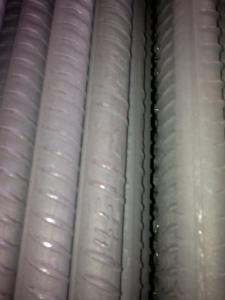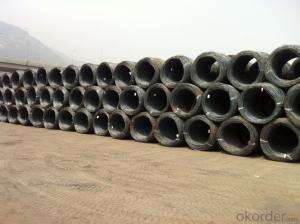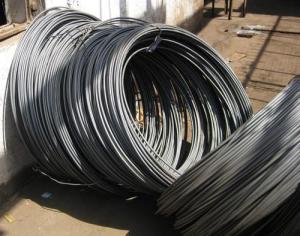Wire rod high quality hot rolled 5.5mm-14mm
- Loading Port:
- Tianjin
- Payment Terms:
- TT OR LC
- Min Order Qty:
- 25 m.t.
- Supply Capability:
- 20000000 m.t./month
OKorder Service Pledge
OKorder Financial Service
You Might Also Like
WIRE ROD Details:
| Minimum Order Quantity: | m.t. | Unit: | m.t. | Loading Port: | |
| Supply Ability: | m.t./month | Payment Terms: | TT OR LC |
Product Description:
Steel Grade: Q195 Standard: ASTM, GB
Diameter: 5.5mm, 6.5mm, 7mm,8mm,9mm,10mm,12mm,14mm
6.5mm can be drawing into 2mm/8.0mm can be drawing into 3mm
Type: Drawn Wire in Coil, each coil weight about 2MT
Brand Name: N-RIVER Place of Origin: Hebei, China
Chemical Composition:
Please kindly find our chemistry of our material based on Q195 as below for your information
Trademark | Rank | Chemical composition (quality score) % | |||||
C | Si | Mn | S | P | |||
≤ | ≤ | ≤ | |||||
Q195 | 0.06-0.12 | 0.30 | 0.25 | 0.050 | 0.045 | ||
Trademark | Rank | Pulling Test | |||||
Bend PointΔs/Mpa | Tensile Strength | Elongation Ratioδ5% | |||||
Thickness (Diameter) /MM | Thickness (Diameter) /MM | ||||||
≤16 | 16-40 | ≤16 | 16-40 | ||||
≥ | ≥ | ||||||
Q195 | 195 | 185 | 315-390 | 33 | 32 | ||
Usage and Applications of Wire Rod Q195:
After hot-rolled the products shaped into coil and delivery as finished product, including round, square, rectangular, hexagonal and so on. Since most of the products are round, it is generally called wire rod. Carbon steel wire rod is widely used in construction and manufacturing. Carbon steel wire rod is mainly used for reinforcement of reinforced concrete and welded structure or reprocessed (roberts , nail, etc.) materials, especially used to produce wire drawing, welding electrode, nails, spring, electronic, precise machinery parts and so on
Wire Rod in Container
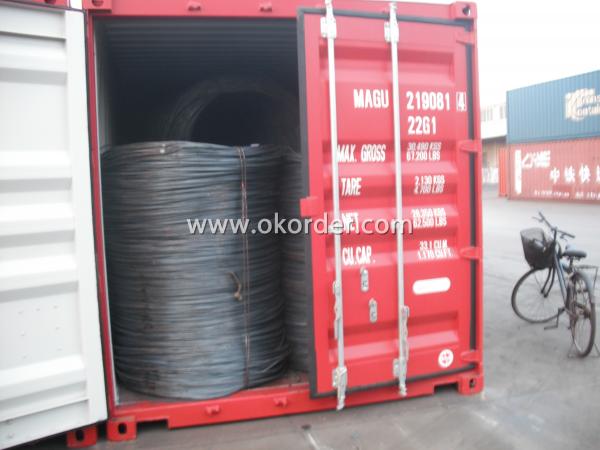
Wire Rod in Bulk Vessel
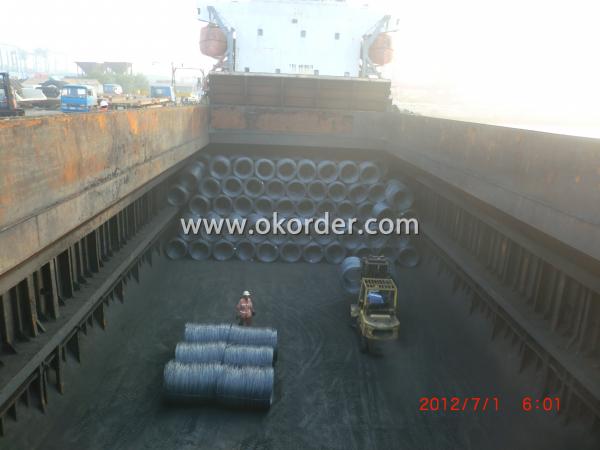
Note:
- Q: How are steel wire rods used in the manufacturing of tire reinforcements?
- Tire reinforcements heavily rely on steel wire rods, as they are vital for providing strength and durability to tires. Their purpose is to guarantee optimal performance and long lifespan. In the tire manufacturing process, steel wire rods are primarily utilized as the primary material to reinforce the tire's inner structure. They are commonly employed to strengthen the tire's carcass, which is responsible for its shape and structural integrity. Typically, steel wire rods are embedded within a layer of rubber known as the tire ply. This involves either weaving or spiraling the rods into the rubber ply, resulting in a robust and stable framework that supports the overall structure of the tire. This reinforcement is essential to maintain the tire's shape, resist deformation, and handle the stress and load it endures during operation. Steel wire rods are favored for tire reinforcements due to their exceptional flexibility and high tensile strength. They possess the capability to endure immense pressure and strain, ensuring the tire remains stable and durable, even in challenging road conditions. Moreover, steel wire rods used in tire manufacturing undergo different treatments and coatings. These treatments enhance their resistance to corrosion and improve their bonding with the rubber compound. Consequently, the rods remain securely embedded within the tire ply, preventing any separation or detachment during use. In conclusion, the significance of steel wire rods cannot be overstated in the manufacturing of tire reinforcements. They provide the necessary strength, stability, and durability required for tires to perform at their best. Utilizing steel wire rods ensures that tires can withstand the various demands of the road, ensuring safety and longevity for drivers and their vehicles.
- Q: What are the different sizes of steel wire rod available?
- The sizes of steel wire rod available vary depending on the specific requirements and applications. Common sizes range from 5.5mm to 14mm in diameter, but it's essential to note that manufacturers can produce wire rods in custom sizes to meet specific needs.
- Q: What are the different production processes involved in steel wire rod manufacturing?
- The manufacturing of steel wire rods involves several production processes. These processes are crucial in transforming raw materials into the final product. Here are the different production processes involved in steel wire rod manufacturing: 1. Ironmaking: The steel wire rod manufacturing process begins with ironmaking. Iron ore is extracted and processed in a blast furnace to produce pig iron. The pig iron is then further refined to remove impurities and create steel. 2. Steelmaking: In the steelmaking process, the pig iron is melted in a furnace and alloyed with various elements such as carbon, manganese, and silicon to achieve the desired steel properties. This process ensures that the steel meets the specific requirements of wire rod production. 3. Continuous Casting: After steelmaking, the molten steel is cast into billets or blooms using continuous casting technology. This process involves pouring the molten steel into a water-cooled mold to solidify it into a specific shape. For wire rod production, the billets are typically cast in a square cross-section. 4. Hot Rolling: The next step is hot rolling, where the billets are reheated and passed through a series of rolling mills. These rolling mills reduce the billets' cross-sectional area and elongate them into wire rod form. The hot rolling process improves the mechanical properties and surface finish of the wire rods. 5. Cooling: Once the wire rods are hot rolled, they undergo a cooling process to achieve the desired properties. Cooling can be done through air cooling or water spray cooling, depending on the specific requirements of the wire rods. 6. Surface Treatment: After cooling, the wire rods undergo surface treatment processes such as pickling or coating. Pickling involves removing any scale or oxide on the surface of the wire rods using acid solutions. Coating may involve applying a protective layer to prevent corrosion or improve the wire rods' performance in specific applications. 7. Inspection and Quality Control: Throughout the manufacturing process, the wire rods undergo rigorous inspection and quality control measures. This ensures that the wire rods meet the required standards and specifications. Various tests, such as tensile strength, elongation, and dimensional checks, are conducted to ensure the quality of the wire rods. 8. Packaging and Delivery: Finally, the wire rods are packaged according to customer requirements and prepared for delivery. They may be bundled, coil-wound, or packaged in other forms, depending on the customer's needs. The wire rods are then transported to the customers, where they can be further processed or used in various applications. These production processes play a vital role in the manufacturing of steel wire rods, ensuring that they meet the required specifications and are suitable for different applications in industries such as construction, automotive, and manufacturing.
- Q: What are the recent developments and innovations in steel wire rod production?
- Some recent developments and innovations in steel wire rod production include the introduction of advanced wire rod mills that utilize high-speed rolling technologies, such as the MEERdrive® system, to increase productivity and improve product quality. Additionally, there have been advancements in the use of automation and artificial intelligence to optimize the production process, reducing energy consumption and minimizing waste. Furthermore, manufacturers are investing in research and development to develop new alloys and coatings that enhance the strength, durability, and corrosion resistance of steel wire rods, expanding their applications in diverse industries such as automotive, construction, and aerospace.
- Q: What are the advantages of using alloyed steel wire rod?
- There are several advantages of using alloyed steel wire rod. Firstly, alloyed steel wire rod offers improved strength and durability compared to regular steel wire rod. This makes it suitable for applications that require high tensile strength and resistance to wear and tear. Additionally, alloyed steel wire rod has better corrosion resistance, making it ideal for use in outdoor or corrosive environments. Furthermore, alloyed steel wire rod can be easily formed and manipulated, allowing for a wide range of applications in various industries such as automotive, construction, and manufacturing. Overall, the use of alloyed steel wire rod provides enhanced mechanical properties, increased longevity, and greater versatility compared to regular steel wire rod.
- Q: What are the common industry best practices for steel wire rod distributors?
- Some common industry best practices for steel wire rod distributors include maintaining a well-organized inventory management system, ensuring timely delivery of products, adhering to quality control standards, providing excellent customer service, building strong relationships with suppliers and customers, regularly monitoring market trends and adjusting pricing strategies accordingly, and continuously investing in technology and equipment to improve efficiency and productivity.
- Q: How are steel wire rods used in the manufacturing of tire belts for vehicles?
- Steel wire rods are used in the manufacturing of tire belts for vehicles as they provide strength and reinforcement to the tire structure. These rods are typically woven into a mesh or laid in a parallel arrangement to form the belt layer, which helps to enhance the tire's stability, durability, and resistance to deformation during vehicle operation.
- Q: What are the different types of steel wire rod finishes for enhanced conductivity?
- There are several types of steel wire rod finishes that can enhance conductivity, including galvanized, electro-galvanized, tin-plated, and copper-coated finishes.
- Q: What are the common industry advancements for steel wire rod?
- Some common industry advancements for steel wire rod include improved manufacturing processes, such as continuous casting and rolling techniques, which result in higher quality and more consistent products. Additionally, there have been advancements in alloying and heat treatment technologies, allowing for the production of steel wire rods with superior strength, durability, and corrosion resistance. Furthermore, innovations in surface treatment and coating methods have enhanced the aesthetics and functionality of steel wire rods, making them suitable for a wide range of applications in industries like construction, automotive, and manufacturing.
- Q: What are the safety precautions to be taken while working with steel wire rod?
- When working with steel wire rods, it is important to follow certain safety precautions to ensure a safe working environment. Some of the precautions include wearing appropriate personal protective equipment (PPE) such as gloves, safety glasses, and steel-toed boots to protect against potential injuries. Additionally, workers should be trained on proper handling techniques, ensuring they are familiar with the weight and dimensions of the wire rods to prevent strain or accidents. It is crucial to use the right tools and equipment for cutting, bending, or manipulating the wire rods to minimize the risk of injury. Regular inspections of the wire rods for any defects or damages are also necessary to prevent accidents. Lastly, maintaining a clean and organized workspace, removing tripping hazards, and implementing proper storage procedures for the wire rods are essential to prevent accidents and injuries.
Send your message to us
Wire rod high quality hot rolled 5.5mm-14mm
- Loading Port:
- Tianjin
- Payment Terms:
- TT OR LC
- Min Order Qty:
- 25 m.t.
- Supply Capability:
- 20000000 m.t./month
OKorder Service Pledge
OKorder Financial Service
Similar products
Hot products
Hot Searches
Related keywords
